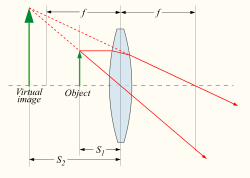Lenses: Difference between revisions
| Line 14: | Line 14: | ||
==== Thin Lens Equation and Magnification ==== | ==== Thin Lens Equation and Magnification ==== | ||
[[File:lens3b.svg| | [[File:lens3b.svg|200px|thumb|A ray tracing diagram for a converging lens.]] | ||
Thin lenses produce focal points on either side that can be modeled using the lensmaker's equation. Thin lenses follow a simple equation that determines the location of the images given a particular focal length (<math>f</math>) and object distance (<math>S_1</math>): | Thin lenses produce focal points on either side that can be modeled using the lensmaker's equation. Thin lenses follow a simple equation that determines the location of the images given a particular focal length (<math>f</math>) and object distance (<math>S_1</math>): | ||
Revision as of 18:01, 29 November 2015
Lenses are found in a huge array of optical instruments, ranging from a simple magnifying glass to the eye to a camera’s zoom lens. Law of refraction is used to explore the properties of lenses and how they form images.
The Main Idea


Index of refraction depends on the wavelength. Thus, light of different wavelengths is bent, or deflected, by different amounts as it passes through a lens. The shape of a lens, either concave or convex, also plays a role in the deflection pattern of light. The images above show that how these two shapes determines the behavior of the light rays. A lens where the middle is thicker than the two ends is called a "convex" lens, through which incoming light rays converge towards the center axis of the lens. A lens where the middle is thinner than the two ends is called a "concave" lens the prisms represent a "diverging" lens, through which incoming light rays diverge away from the center axis. The angle at which light rays converge or diverge is called the deflection angle. Deflection angles for thin lenses will be modeled mathematically in the following section. Thin lenses are lenses where the y position of a light ray does not change very much as the light ray travels through it. In other words, the lens is thick enough to refract light rays, but does not allow dispersion or aberrations.
A Mathematical Model
Law of Refraction
Refraction occurs when light travels through an area of space that has a changing index of refraction. The simplest case of refraction involves a uniform medium with index of refraction [math]\displaystyle{ n_1 }[/math] and another medium with index of refraction [math]\displaystyle{ n_2 }[/math]. The following equation describes the resulting deflection of the light ray:
- [math]\displaystyle{ n_1\sin\theta_1 = n_2\sin\theta_2\ }[/math]
Thin Lens Equation and Magnification

Thin lenses produce focal points on either side that can be modeled using the lensmaker's equation. Thin lenses follow a simple equation that determines the location of the images given a particular focal length ([math]\displaystyle{ f }[/math]) and object distance ([math]\displaystyle{ S_1 }[/math]):
- [math]\displaystyle{ \frac{1}{S_1} + \frac{1}{S_2} = \frac{1}{f} }[/math]
The magnification of a lens is given by
- [math]\displaystyle{ M = - \frac{S_2}{S_1} = \frac{f}{f - S_1} }[/math]
A Computational Model
Examples
Determine the Index of Refraction from Refraction Data

Find the index of refraction for medium 2 in Figure1 (a), assuming medium 1 is air and given the incident angle is 30.0º and the angle of refraction is 22.0º.
Strategy
The index of refraction for air is taken to be 1 in most cases (and up to four significant figures, it is 1.000). Thus [math]\displaystyle{ n_1 = 1.00 }[/math] here. From the given information, [math]\displaystyle{ \theta_1 = 30.0º }[/math] and [math]\displaystyle{ \theta_2 = 22.0º }[/math]. With this information, the only unknown in the lens equation is [math]\displaystyle{ n_2 }[/math], so that it can be used to find this unknown.
Solution
- [math]\displaystyle{ n_1\sin\theta_1 = n_2\sin\theta_2\ }[/math]
Entering known values,[math]\displaystyle{ n_2 = 1.33 }[/math].
Middling
Difficult
Connectedness
- How is this topic connected to something that you are interested in?
- How is it connected to your major?
- Is there an interesting industrial application?
History
Put this idea in historical context. Give the reader the Who, What, When, Where, and Why.
See also
Are there related topics or categories in this wiki resource for the curious reader to explore? How does this topic fit into that context?
Further reading
Books, Articles or other print media on this topic
External links
Internet resources on this topic